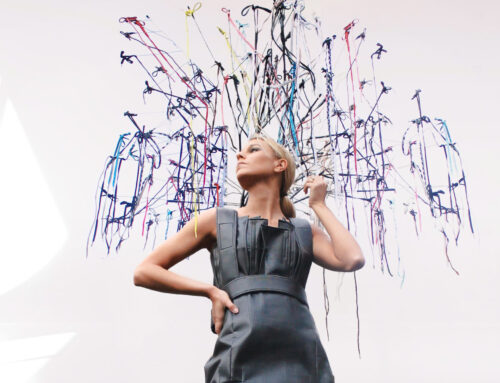The traveler remained silent as the old Iban Dayak woman gazed at her tattooed hands with a far-off look in her clouded eyes. She explained with a proud cackle that each tattooed star represented a different lover from her youth. Then, suddenly, she grabbed his wrist with a talon-like grip, pulled him close and said something he will never forget.
“The object of growing old gracefully is to collect beautiful memories.”
For Steven Alpert, then a young man visiting Sarawak, the northwest tip of Borneo, it was a profound moment. He had been marked a few years earlier with the royal crest of an Indonesian Raja and received the “eyes” of an Iban warrior on his shoulders while in Borneo. He has carried the markings as well as the old woman’s words with him ever since. Now, a middle-aged family man living in Preston Hollow, when he reflects on his tattoos and his decade spent in Indonesia, he realizes that his experiences have made a much deeper impression on him than the ink on his skin.
“Those tattoos are fading. They’re distant memories. In a way that’s what a tattoo ought to be. A fading tattoo can be a beautiful memory,” he says. “I don’t know they’re even on my body anymore. But the memory of the old lady will never vanish. And the wisdom of her story is eternal.”
Tattoos have been a part of the human experience for thousands of years in virtually every culture – from the ancient Egyptians’ hieroglyphic body art to early Chinese emperors to tattoos identifying gang membership in American prisons. They have also become quite the trendy thing to do in the past few years, most notably lower-back tattoos on women and tribal tattoos on men.
But despite the seeming societal acceptance of tattoos, there is still a stigma, or perceived stigma, attached to the idea of permanently marking ones skin with ink. Below are two very different tattoo stories that shed some light on the essence of the art.
NATIVE SON
Alpert says both of his tattoos came about by accident. His story began in 1970 as he waited for his first semester to begin at Auckland University in New Zealand. He had a few months to kill, so he visited several Indonesian islands. It didn’t take long before he had fallen in love with the people and geography of the region.
Like most boys in the 1950s and early ’60s, Alpert had his Roy Rogers lunchbox, a six-shooter and grew up on a steady diet of cowboy and Indian movies. But as a boy with roots in upstate New York, he was also drawn to the area’s native people, in particular, the Mohawks.
Alpert’s interest in the Pacific was awakened at the age of 11 when he read the Thor Heyerdahl classic Kon Tiki, about the author’s voyages to Polynesia.
“Through the years, while the other kids were going through that 1950s experience, my experience was drifting to the other side. And I began to read books about native cultures, the age of European exploration – about far away places.”
One of those far away places was the remote island of Roti, just off the coast of Timor. It was there, in 1972, that Alpert met the Raja, or king, of the Kingdom of Landu, and received his first tribal tattoo.
It all began when the Raja asked him to attend a meeting of tribal leaders at a neighboring village. The long trip would have to be made by horseback. Alpert recalls that he had ridden a horse before, but not without a saddle. And while he made it to the ceremony unscathed, on the way back, riding bareback in the hot afternoon sun, Alpert became more and more uncomfortable. With only a mile or two left to go, he felt something warm, sticky and wet on his backside.
“I realized I had no more skin on my backbone; I was bleeding everywhere. But remember, here I was living in the house of a Raja, and damned if I was going to embarrass the old man.”
Instead, he envisioned that the Raja’s herd of Asian buffalo grazing nearby was a herd of American bison, and with a “hee-haw,” Alpert spurred the horse, dodged in and out of the herd as if he was on a great hunt, and made it back to the village. With what dignity he had left, he peeled himself off of the back of the horse and spent the next three days bed-ridden, unable to walk. When the Raja visited him, he had a wry smile on his face and a big surprise.
“Well, the old king came up to me while I was laying there a day or two later in discomfort and said: ‘That was a very brave thing you did. I’m proud of you like you were my son. Would you like to be tattooed with the mark of our family?’”
To be his honorary son, Alpert would be marked with the Raja’s royal crest so that “everybody will know that you are the son of the king.”
The tattooing process itself was very primitive, Alpert says, though not without ceremony. The Raja’s wife applied the tattoo using a long thorn to poke the ink into his skin, while the island’s most famous blind band played a string instrument called a sesandu. Alpert wrote in a letter an exotic cross between the “guttural blues of Blind Lemon Jefferson and Ravi Shankar [India’s virtuoso on the sitar].
“[The music] just transported me to another universe. It was magical.”
Alpert was tattooed a second time while living with the famed Iban Dayak community of Borneo. First introduced to an American audience by P.T. Barnum’s “Wild Man of Borneo” exhibit at Coney Island, the Dayak people were known for their extensive tattoos and epitomized by their headhunting past. Alpert found that the practice of headhunting was revived briefly after World War II as the Dayaks took revenge on the Japanese for their cruel treatment of them during the war. He says his mentor and friend on the island, Kilat, would have been the equivalent of a battle captain or warrior had headhunting still been practiced at the time. It was Kilat who taught him how to fish and hunt like an Iban tribesman. The Penggulu, or head chief of the river basin took notice of his newfound, if rudimentary, Iban skills.
“You remind me of a son who’s passed away, and I think you should be tattooed now that Kilat has taught you how to fish, how to hunt,” the Penggulu told Alpert. “You need to be tattooed as you are now ‘kami Iban,’ one amongst us Iban.”
Alpert did make one request of Kilat, who was chosen to do the tattoo.
“’Kilat, make this very small,’ I said. ‘I don’t want a big tattoo. I don’t want to seem unseemly,’” he recalls. “He just laughed and said, ‘Well,you’ve come a long way. You’re a big man. Big men get big tattoos.’”
Alpert learned that for the Iban Dayak people, a tattoo is part of a bejalai, and arduous physical journey or rite of passage, and marks a special memory. The tool used to create the tattoo was made up of six needles, bound together with a bamboo stick. After being dipped in the ink, the needles were hammered into his shoulders to create the markings. The entire village came to watch. As Kilat worked, Alpert could hear the tap, tap, tap in the background. A line of longhaired tattooed elders exhorted him to be brave. Twelve hours later, with only two 15-minute breaks, Alpert had two large tattoos on each shoulder depicting an egglplant blossom with a double spiral in the center.
“What they mean is that these are, if you will, a type of yin-yang symbol, representing the absolute female and absolute male coming together within yourself,” he says. “These were the first tattoos given to a battle-tested warrior. They became his eyes in the jungle, eyes to see, eyes so animals wouldn’t hurt you, and eyes so that your ancestors, when you did die, would recognize you.”
Alpert collected stories like these during a time of great transition. Though they were quite aged, he says he felt privileged to know male elders who had actually been headhunters, and women who had been weavers of sacred blankets inspired by dreams and visions from their youth. He also collected some beautiful art, much of it now on permanent display in the Dallas Museum of Art.
His advice to those contemplating a tattoo: “Like I tell my own children, remember that it should be about something special that you’ve done, a place you’ve been, as it is something you have to wear for your entire life. So put it in a subtle place so you have the idea that the experience is yours. Then you can choose whether to show it or keep it to yourself. Because your life will change.”
NATIVE TEXAN
Like Alpert, Margaret Devine, 31, never intended to get a tattoo, but natives intervened and made the decision for her. Of course in her case the natives were a couple of fellow Texans in their freshman year at Stephens University in Missouri.
It was one of those nights in the dorm that seemed to drag on forever. With nothing to do but sit around and talk about home, the three girls started missing their friends and families – and the state of Texas in general. Then one of them came up with the bright idea that they should get a tattoo of the Lone Star State.
“I was totally roped into doing it,” Devine says. “I had no desire to get a tattoo.”
Nevertheless, when it was finished she liked it, thought it was cool. When she went home for winter break, her dad noticed it the first time she walked by in her bare feet.
“I remember my dad saying, ‘What is that?’ Then I started thinking about how dumb it was. But I thought it was pretty cool still. My senior year, when I was graduating, and I knew I was about to go into the real world I thought, ‘Why did I do this? How do you explain it to your grandkids?’”
Since then she has regretted getting the tattoo every time she or somebody else sees it. She tells the story of a trip to the salon for a pedicure. When the non-English-speaking pedicurists saw the blue Texas on the top of her foot, they began pointing and laughing.
“Now I hide it. I camouflage it,” she explains. “When people see it they just look at me and laugh and say, ‘Why did you do that?’ I’m the last person you would expect to have one.”
It’s not surprising that some people’s reactions are less than enthusiastic. For decades, tattoos were considered the mark of a savage or criminal – at the very least a person from the wrong side of the tracks. Even though they have gained popularity in recent years among the 18 to 30 crowd, there is still something taboo about tattoos.
But there is also something timeless about tattoos that attracts new converts everyday. Maybe it’s because of their perceived permanence. Maybe it’s because of their roots in the earliest civilizations. Maybe it is something much more personal.
When asked why she hasn’t simply paid to have the offending ink stain removed, Devine had to think about it for a second.
“You know what? I think it’s really a memory I don’t want to let go of. It’s a memory I don’t want to let go of. It’s a memory of the good ol’ days, my college years, and maybe that’s why I haven’t removed it.
“I didn’t realize that until just now. It’s that memory.”
Somewhere in the spirit world an old Iban woman is smiling.






